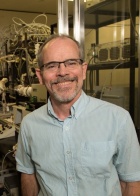[POSTPONED] Mike Harold
M.D. Anderson Professor and Chair
Amol Ajinkya Memorial Fund Lecture
Department of Chemical and Biomolecular Engineering
University of Houston
Multi-Functional Structured Catalysts For Clean Exhaust from Lean Burn Vehicles
The U.S. faces the difficult dual challenge of reducing the consumption of transportation fuels and improving air quality. Lean burn gasoline, diesel, and natural gas engines are of interest because they are more fuel efficient than conventional stoichiometric gasoline engines. Unfortunately, the unconverted oxygen in the exhaust prevents the use of the conventional three-way catalytic converter to reduce nitrogen oxides (“NOx”) to N2. In this talk we describe progress towards the combination of two NOx reduction technologies, NOx Storage and Reduction (NSR) and Selective Catalytic Reduction (SCR).
Research in our group uses a combination of experimentation and modeling, both to provide deeper insight and to devise “optimal” structures and operating strategies for emission control technologies. NSR is shown to be a promising but complex catalytic process that involves the sequential periodic reactive trapping of NOx and its rapid reduction on multi-functional catalysts containing precious metal and storage components. SCR is adopted from the stationary source process which utilizes NH3 as the NOx reductant, and utilizes both Cu- and Fe-exchanged zeolite catalysts. As stand-alone reactors, NSR has the noted disadvantage of cost (precious metal) and byproducts (NH3, N2O), while SCR requires an aqueous urea system to provide the NH3, which may “slip” from the reactor under the inherent transient vehicle operation. Moreover, both NSR and SCR have constrained temperature operating windows (low and high). Multi-functional catalyst architectures that combine two or more active layers or zones can be effective strategies to address cost and/or performance limitations. The “NSR + SCR” catalyst combines periodic NOx storage and reduction with in situ NH3 generation and selective catalytic reduction of NOx. To be described are results from targeted experiments as well as kinetic and reactor modeling that advance our understanding of these interesting catalytic reaction systems.
Biography
Dr. Michael P. Harold is the M.D. Anderson Professor and Department Chair of Chemical and Biomolecular Engineering at the University of Houston. With expertise in reaction engineering and catalysis, Harold is the author of more than 150 peer-reviewed papers and has given over 260 presentations and invited lectures. He is the founder and principal investigator of the University of Houston’s Texas Center for Clean Engines, Emissions & Fuels (TxCEF), established in 2003. Mike was appointed Editor-in-Chief of the AIChE Journal in late 2011, the 7th in the Journal’s 60-year history.
A Pittsburgh, PA native, Harold received his Bachelor’s degree at Pennsylvania State University, and his PhD from the University of Houston. He joined the faculty at University of Massachusetts at Amherst in 1985 where he became Associate Professor. In 1993 Harold joined DuPont Company, where he held several technical and managerial positions. In 2000 Harold returned to the University of Houston where he became the Dow Chair Professor and Department Chair, a position he held for 8 years. He was re-appointed to that position in early 2013. In 2010 Harold was named the M.D. Anderson Professor. His honors include the 2013 Ester Farfel Award at the University of Houston (highest honor bestowed on a faculty member) and the American Chemical Society’s Fuel Division Richard A. Glenn Award.
Wednesday, September 12, 2018 [POSTPONED]
- Time: 11.00 AM
- Location: 206 Furnas Hall
- Seminar Flyer

Mike Harold, Ph.D.
M.D. Anderson Professor and Chair
University of Houston